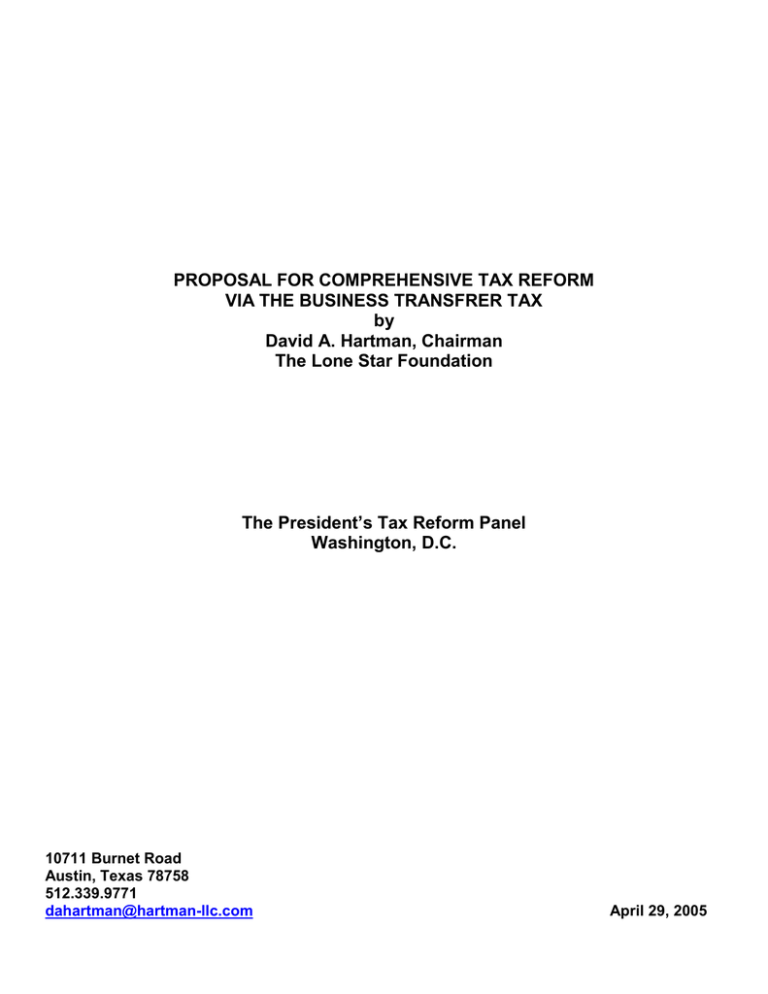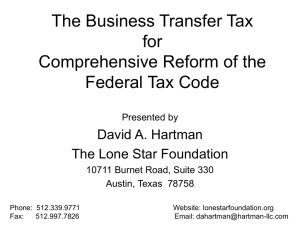PROPOSAL FOR COMPREHENSIVE TAX REFORM VIA THE BUSINESS TRANSFRER TAX by
advertisement

PROPOSAL FOR COMPREHENSIVE TAX REFORM VIA THE BUSINESS TRANSFRER TAX by David A. Hartman, Chairman The Lone Star Foundation The President’s Tax Reform Panel Washington, D.C. 10711 Burnet Road Austin, Texas 78758 512.339.9771 dahartman@hartman-llc.com April 29, 2005 PROPOSAL FOR COMPREHENSIVE TAX REFORM VIA THE BUSINESS TRANSFER TAX EXECUTIVE SUMMARY The U.S. has experienced a profound reversal of the competitiveness of its industrial sector, primarily due to the federal tax code. Double taxation of saving for investment and high marginal income tax rates on domestic producers are serious barriers to sufficient domestic capital formation. But the tax code’s most problematic feature is lack of border adjustment. The disadvantages for U.S. producers of border adjusted VATs averaging 18% added on U.S. exports to foreign markets, and 18 percent rebated on foreign imports in U.S. markets are virtually insurmountable, given the rapid diffusion of technology and innovation in world markets. Single rate taxation on consumption with deferral of taxation on saving for investment until consumed proposed by most tax reform alternatives, must also be joined with border adjustment comparable to foreign VATs in order to arrest the demise of the U.S. manufacturing sector, as well as to provide territoriality to retrieve corporate headquarters and combat outsourcing of business services. The Business Transfer Tax (The BTT), a subtraction method value added tax is proposed as the most efficient, equitable and growth oriented basis for border adjusted and consumption based taxation, on the broadest base and at the lowest rate. At a 17% rate, the BTT would provide “tax revenue neutral” replacement of the individual and corporate income taxes, employer social insurance taxes, the estate and gift taxes, plus customs duties. The BTT at a “tax burden neutral” rate of 18.2% would replace these taxes, plus based upon the current three quarters of a trillion dollars trade deficit would provide $127 billion “found money” from levy on net imports, first to provide funding for transition costs, then for closing of the federal deficit. The BTT is the best prospect for accelerating growth of investment and incomes for all Americans as a consequence of closing the trade deficit, the fiscal deficit and the soaring gap, plus restoration of a sound currency. Created 4/27/05, modified 4/29/05 PROPOSAL FOR COMPREHENSIVE TAX REFORM VIA THE BUSINESS TRANSFER TAX THE NECESSITY OF COMPREHENSIVE TAX REFORM The U.S. has experienced a profound reversal of competitiveness from the world’s dominant industrial power to a country that is failing to compete effectively at home or abroad. This reversal is principally due to a federal tax code that is asymmetrical to the border adjusted value added taxation of all our foreign competitors, and that disincentivizes the productive processes of the American economy. The U.S. manufacturing sector share of GDP has declined over 50 percent, and over 60 percent as a share of employment. Currently the U.S. has a trade deficit in goods with every principal country in every category of good except federal subsidized aircraft. Only $2 worth of every $3 in goods the U.S. consumes is currently domestically produced. A similar trend is developing in the business services sector due to foreign outsourcing, in part due to removal of corporate headquarter abroad. “Supply side” economists have made a persuasive case for reform of a federal tax code that double taxes saving for investment at progressive marginal rates, and replacing it with proportional consumption taxation and deferral of saving for investment until consumed. But they have left unaddressed foreign replacement of tariffs with border adjusted value added taxation (VATs) of goods not afforded U.S. manufacturers. Under U.S. leadership since WWII average OECD tariffs declined from 40 percent rates to 4 percent, (1.7 percent for the U.S.). However, starting with Europe all principal U.S. competitors have now replaced tariffs with border adjusted VATs averaging 18 percent. Consequently, U.S. goods carry a full burden of U.S. federal, state, and local taxes, plus an added 18 percent in foreign markets, and face foreign goods enjoying 18 percent VAT rebates in U.S. domestic markets. The U.S. trade deficit and the virtual demise of the U.S. manufacturing will not be resolved satisfactorily without border adjusted – not just consumption based – tax reform. Devaluation has not and will not resolve this crisis as long as the U.S. is willing to exchange its productive assets for foreign trinkets, (“America for Sale”); nor will U.S. productivity and innovation prevail given its rapid diffusion abroad. 3 TAX REFORM CRITERIA AND ALTERNATIVES The crisis described clearly established border adjustability as a, if not the, most important criterion, critical for effective tax reform. Its potential effect upon competitiveness, and reversal of manufacturing and business service sectors from decline to growth make a more urgent political case for tax comprehensive reform. Current contenders as alternatives for tax reform all are comparable in being consumption based, deferring taxation of saving for investment until consumed, and lowering marginal rates usually with a single “flat” rate; or, “hybrids” based upon a dual tax reform. The devil, however, lies in the details. Also important is the necessities that reform should simplify the code, and that any new tax should be in replacement of not in addition to current taxes, realistically assessable politically, and justified on a revenue neutral basis. Of the five alternatives most seriously proposed for fundamental consumption based tax reform, the “Flat Tax” and the “consumed income tax” are “direct taxes” that cannot be border adjusted under WTO rules. Both the “retail sales tax” and the European-type “credit invoice VAT taxes” are “indirect” and therefore WTO qualified, but both have proven limited in breadth of assessable tax base for political reasons, resulting in unacceptably higher rate and/or lesser revenue yield, limiting capability for comprehensive replacement of undesirable taxes. The “business transfer tax (BTT)” as a “subtraction method VAT” is an indirect tax on consumed income which should be assessable on all commerce and government for the broadest base and the lowest marginal rate, and WTO qualified for border adjustment; as such it is proposed as the best candidate for comprehensive tax reform. DESCRIPTION OF THE PROPOSAL It is proposed that three-quarters of the federal tax code be fundamentally reformed by replacing corporate and individual income and related federal taxes with an indirect consumption based and border adjusted Business Transfer Tax (the BTT). The tax base for the BTT would be a levy upon all commercial activity and governments determined as follows: BTT TAX BASE 4 Commercial: All Revenues (Excluding Export Sales) less: All Purchases of Goods and Services (Including Equipment and Structures, but Excluding Imports) less: All Charitable Qualifying Donations Governmental: All Employment Expenses All Imported Goods and Services As such the BTT is a consumption tax which is levied upon value added after exemption of investment, which is border adjusted by exclusion of exports and inclusion of imports. All commercial activity is proposed for inclusion whether by corporations, partnerships, individuals, or non-profits. Governments are included by levy on employment and the inclusion of BTT in their consumption expenditures at the commercial level. The BTT based is estimated at the macro level as final sales of GDP, less gross commercial private investment and private philanthropic giving (see EXHIBIT I-A attached). The proposed BTT receipts were determined as the total necessary to fully replace the following present federal taxes: BTT FEDERAL TAXES TO REPLACE Individual Income Taxes Corporate Income Taxes OASI, DI and HI Employer Taxes Estate and Gift Taxes Customs Duties and Fees Replacement of these taxes was estimated as tax revenue neutral for FY 2003 federal taxation (see EXHIBIT I-B). Also included was provision for rebates of BTT on family based poverty level income totaling $1.5 billion (EXHIBIT I-C). After transition serious consideration should be given to conversion of rebates to vouchers for deposit to universal medical savings accounts. 5 The BTT tax rate estimated on this basis is a single rate 17 percent as shown in EXHIBIT ID. The 17 percent BTT is tax revenue neutral, but is a lesser burden to U.S. taxpayers due to border adjustability adding net foreign imports to the tax base. At one half of a trillion dollars the FY 2003 current trade deficit taxed at 17 percent BTT provided 87 billion per year “found money” as lesser burden for U.S. taxpayers. If the BTT were levied at an 18.2 percent tax burden neutral rate, at the current three quarter of a trillion dollars current trade deficit it would provide $127 billion “found dollars” for federal deficit reduction. OTHER ISSUES Provision for equitable transition could be provided by a reasonable transition to the BTT over a three year period by levying the BTT in one-third increments, while phasing out the present code in one-third increments. Undepreciated assets could be accelerated over a ten year period at the BTT rate. A phase-in of the BTT would result in less of a shock to foreign producers and allow replacement of manufacturing capacity to minimize inflationary pressures. The distribution of the BTT relative to lower and middle incomes is comparable to the present tax code’s standard deduction, exemptions, and credits in total, given proposed replacement of employer social insurance taxes (generally considered effectively incident upon employees), plus rebates on poverty level incomes. It is intended that it be legislated that an annual amount of money be transferred to the OASI, DI, and HI trusts equal to individual FICA and Medicare taxes as from current employer taxes; as assessed, this effectively eliminates the so-called “bubble”, since the individual portion is self-serving. Whether a single rate BTT is effectively less progressive than present individual personal and business taxation is a complex question of effective incidence. There is persuasive evidence that the ultimate burden of progressive and multilayered taxation of physical and even intellectual capital does not really redistribute income. An intended consequence of this proposal is to return to a tax code where all citizens are taxed proportionate to what they consume, except for the bare necessities, comprising the most equitable basis, and the basis for optimal growth of all incomes. 6 Exemption of charitable giving would be provided for all commercial sources of income by the definition of the tax base, which would allow deduction. Wage and salary earners and other noncommercial sources would be allowed to file for rebates on their charitable donations. The treatment of home ownership would be much the same as under the present tax code, in that cost of home building includes income taxes at present which would be replaced by the BTT, and since home purchases are not expensed, home resales would not be taxed, nor would home rentals be expensed as at present. Home mortgage interest would not be tax deductible, but would receive the offsetting benefit of lower interest rates due to greater supply of saving for investment. Current home owners’ mortgage interest deduction should be considered for transition cost rebates for as long as current rates remain fixed. Determination of BTT obligation and collection should be via tax returns which would use data already collected for income taxes and be far simpler returns. The importers and exporters would typically be responsible for paying BTT on imports, and filing for rebate of BTT on exports. The BTT can be rendered as transparent as a retail sales tax by requiring a statement of BTT rate upon all invoices and receipts. This statement would be considered by the IRS as a legal declaration that any purveyor of goods and services has appropriately filed a BTT tax return. The BTT should be even more stable than Gross Domestic Product, in that it excludes from the tax base the more volatile Gross Private Commercial Investment account. The border adjustability of the BTT at the 17 percent or 18.2 percent rates would have a profound effect upon the U.S. manufacturing sector when combined with the expensing of investment. The current trade deficit in goods at over 6 percent of GDP would return to balance of exports and imports as a consequence of leveling the international trade arena given BTT rates imposed on exports and rebated as privileged to all other OECD competitors at rates from 15 percent to 25 percent, averaging 18 percent. Territoriality of corporate profit taxation included in the BTT would result in the return of corporate headquarters which went abroad to escape U.S. taxation of foreign earned profits. The lost business services that served these corporate headquarters would 7 return, and export of business services would be augmented by border adjusted rebates of BTT, and outsourcing diminished due to levies of BTT as imports. CONCLUSIONS AND RECOMMENDATIONS The combined effects of border adjustability and consumption based taxation would create far higher saving for investment and more rapid growth of U.S. output and incomes to help close the federal deficit and close the U.S. saving gap. Given the multiplier effect of capital intensive return to a growing manufacturing sector, U.S. economic growth would boom, and the restoration of vigorous growth in blue collar and family incomes would reinforce that boom. Economic growth could be remarkable. Whereas transition to consumption taxation in general could be expected to add perhaps 5 percent to 10 years economic growth, the BTT could result in more than double that amount. In summary, the border adjusted and consumption based BTT offers the best prospects of any alternative for simple, transparent, equitable, and efficient taxation that ends double taxation of saving for investment, provides a leveling of the foreign trade playing field for U.S. producers and promotion of vigorous growth and stability of output and incomes, plus a return to balanced budgets and a stable currency. A “hybrid” combination of the BTT with either a retail sales tax or a single rate income tax on upper income individuals could provide less desirable, but workable, alternatives. The retail sales tax is just another tax to collect with the same effects at a higher combined rate. Worse still, retaining the income tax could invite the pressures for future finance of an expanded welfare state. What is desirable upon proof of the BTT’s virtues would be revoking the sixteenth amendment for a permanent end to income taxation. 8 EXHIBIT I ESTIMATION OF PROPOSED BUSINESS TRANSFER TAX (Basis: Revenue Neutral FY 2003) A. The BTT Tax Base: (Source: NIPA FY 2003) Final Sales of Domestic Product less: Gross Private Domestic Investment plus: Imports of Goods & Services less: Exports of Goods & Services plus: Owner Occupied Residential Investments less: Owner Occupied Imputed Rent less: Private Philanthropic funding BTT Tax Base Gross $11005.3 bil (1665.8) 1517.0 (1020.5) 310.6 (697.0) (240.9) $9208.7 bil B. Proposed BTT Receipts: (Source: Historical Tables, FY 2006, OMB, FY 2003) Individual Income Taxes Corporate Income Taxes Social Insurance (OASI, DI, HI) 671.0 Employer Share @ 50% x.50 Estate & Gift Taxes Customs Duties & Fees BTT Proposed Receipts Memo:Social Insurance, Individual Other Retirement Receipts Unemployment Insurance Excise Taxes Miscellaneous Receipts Continuing Federal Receipts Total Federal Receipts (FY 2003) $793.7 bil 131.8 335.5 22.0 19.9 $1302.9 bil 335.5 8.6 33.4 67.5 34.5 $ 479.5 bil $1782.4 bil C. Determination of Poverty Level Rebates (Source: BEA FY 2003) Poverty Level Family Incomes 11133 ÷ 2 x 35.9 mil = Two persons 65 = Two persons < 65 = 12384 ÷ 2 x 173.3 mil = Two children ≤ 19 = 18810 (12384) 6426 ÷ 2 x 81.2 mil = Poverty Level Income Rebate Base D. BTT Rate Proposed BTT Proposed Receipts ÷ BTT Base, less Rebate Base BTT Proposed Rate 9208.7 – 1533.8 = Memo: BTT Rebates BTT Rebate Base x BTT Rate BTT Rebates Proposed $ 199.8 bil $1073.1 bil $ 260.9 $1533.8 bil $1302.9 bil ÷ $7674.9 bil 17.0% $1533.8 bil x 17.0% $ 260.7 bil 9




